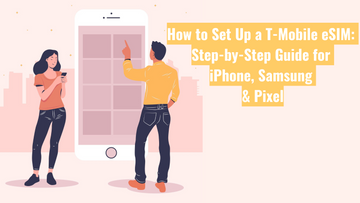The Digital Nomad’s Toolkit: How to Build Your Mobile Office with a Travel SIM

Your Office, Anywhere in the World
Working from a beachfront café in Bali. Taking video calls from a rooftop in Barcelona. Replying to clients over breakfast in Tokyo. For digital nomads, this isn’t a fantasy—it’s everyday life. But all that freedom depends on one thing: a stable and reliable internet connection.
While traditional roaming plans are notoriously expensive, and picking up local SIM cards in every new country gets old fast, there’s a smarter way to stay connected. Enter the travel SIM—specifically, the eSIM.
This guide will walk you through how a travel SIM can become your most powerful remote work tool. Whether you're freelancing from Europe, managing projects in Southeast Asia, or consulting from South America, we’ll show you how to create a mobile office that works wherever you do.
Why a Travel SIM is the Digital Nomad's Best Friend
Cost-Effectiveness Without Compromise
Let’s be real—international roaming can burn a hole in your budget. Most roaming plans offer tiny data allowances at sky-high prices, which just isn’t practical for a working traveller.
Travel SIMs, especially eSIMs, are not only affordable, but many offer regional or global plans tailored for multi-country use. Whether you’re hopping through Europe or spending a few months in Asia, you can get large data bundles at a fraction of the cost of roaming.
Flexibility & Convenience at Your Fingertips
Gone are the days of hunting down a SIM vendor in a foreign country, dealing with local paperwork, or trying to explain your needs in another language. With an eSIM, activation is instant—just scan a QR code and you’re online.
Modern smartphones also support multiple eSIM profiles. This means you can easily switch between data plans depending on your location or purpose—keep one for work and another for streaming and travel. And best of all? No fiddling with tiny SIM cards or adapters.
Reliable, High-Speed Connections
Most travel SIM providers connect you directly to local carriers in each country—so you’re not stuck with throttled speeds like you often are with roaming. For digital nomads, that reliability matters.
Whether you’re hosting a Zoom workshop, uploading large files, or relying on cloud-based tools, having access to high-speed networks can make or break your day.
Building Your Mobile Hotspot Hub: Beyond Just Your Phone
Your Phone as a Primary Hotspot
One of the simplest ways to stay connected is by using your phone as a hotspot. With a travel SIM installed, you can share your mobile data with your laptop, tablet, or any other device.
Tip: To make your battery last longer, keep screen brightness low, turn off non-essential apps, and use power-saving modes while tethering.
Consider a Dedicated Mobile Hotspot (MiFi)
For those juggling multiple devices or travelling in a group, a dedicated MiFi device can be a game-changer. Some even support eSIMs, meaning no physical SIM swap is required.
MiFis provide a stronger and more consistent signal, and they save your phone’s battery when you’re working for hours on the go.
Dual-SIM: The Ultimate Work-Life Balance
One clever setup is to keep your home SIM active (for things like bank verification texts or emergency calls) while using a travel SIM for all your data needs. This dual-SIM approach is especially handy for separating personal use from business tasks—perfect for freelancers and business owners who need clear boundaries.
Real-World Scenarios & Pro Tips for the Working Traveller
Flawless Video Conferencing
Before jumping into a client meeting or team catch-up, find a spot with strong reception—preferably near a window or open space. Keep data usage in check by closing background apps, and always have a backup option ready in case of signal drops.
Many travel SIM apps include usage dashboards, so you can keep track of how much data you’ve used in real-time—preventing mid-call disconnections.
Uploading & Downloading Large Files
When working with heavy files—like media, design, or data sets—you’ll want a fast, unthrottled connection. Schedule uploads during off-peak hours and compress files where possible to save bandwidth.
Travel SIMs connected to local high-speed networks often outperform hotel Wi-Fi, giving you a smoother, more productive workflow.
Navigating Local Life with Ease
Need to grab a ride, order food, or find your Airbnb? A connected phone is your best friend. With your travel SIM running, you’ll have access to Google Maps, ride-hailing apps, local payment systems, and more—without the risk of being stranded in a foreign country without data.
Plus, staying connected means you’re always ready in case of emergencies.
A Note on Security: VPNs & Safe Browsing
While a travel SIM is more secure than public Wi-Fi, it’s still wise to use a VPN when accessing sensitive work materials or logging into company accounts. A little digital hygiene goes a long way when working remotely.
Unlock Your Global Potential
Being a digital nomad is about freedom, flexibility, and designing a lifestyle that works for you. But all of that hinges on one thing: staying reliably connected.
With a travel SIM or eSIM in your toolkit, you can focus on what matters—your work, your adventures, and your peace of mind—without worrying about connectivity.
eSIMs are the future of global mobility. No more roaming charges. No more plastic SIMs. Just seamless access to high-speed networks across the globe.
Ready to take your office global?
Explore our range of travel SIM and eSIM data plans tailored for digital nomads, remote workers, and long-term explorers like you. Your mobile office awaits.











